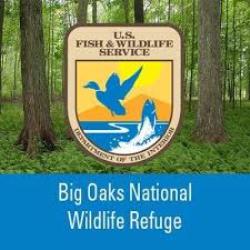
The Big Oaks Conservation Society (BOCS) is the non-profit support group of the Big Oaks NWR. Society members work closely with refuge staff to enhance public awareness, use, and appreciation for the natural and cultural assets unique to Big Oaks NWR. The Society currently maintains and manages Old Timbers Lodge, a beautiful historic structure nestled on a bluff overlooking Graham Creek on the northern portion of the property. Meetings are held the first Monday of each month at 6:30 p.m. usually at the Madison- Jefferson County Public Library in Madison, Indiana.
Big Oaks National Wildlife Refuge (NWR) consists of approximately 50,000 acres on the former Jefferson Proving Ground (JPG) located in Jennings, Ripley, and Jefferson Counties in southeastern Indiana. The refuge is managed by the U.S. Fish and Wildlife Service and provides public use opportunities such as hunting, fishing, wildlife observation and photography, interpretation and environmental education. The refuge has one of the largest contiguous forest blocks in the southeastern part of the state as well as one of the largest grassland complexes in the state, both of which provide wonderful wildlife viewing opportunities to refuge visitors.



